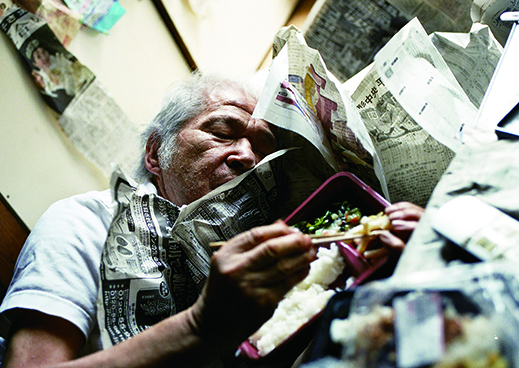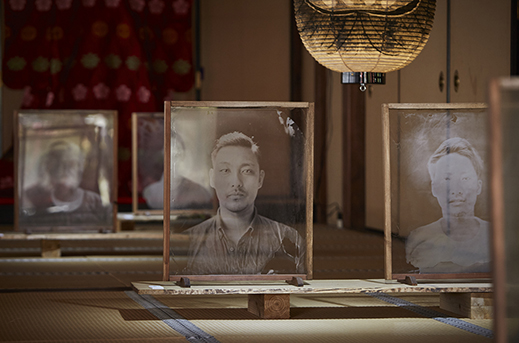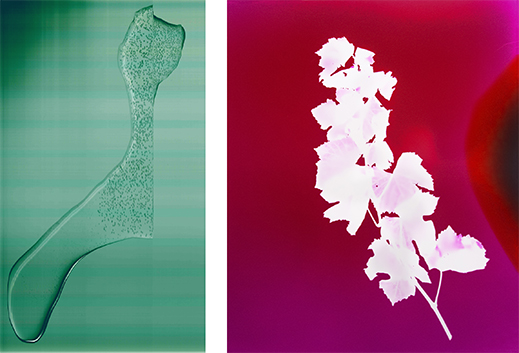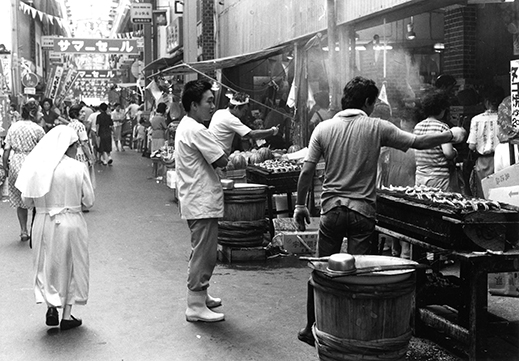 |
 |
 |
HOME > FOCUS > 2020 Vision at KYOTOGRAPHIE, Kyoto's International Photography Festival |
 |
 |
Focus features two in-depth reviews each month of fine art, architecture, and design exhibitions at art museums, galleries, and alternative spaces around Japan. |
|
|
 |
 |
 |
2020 Vision at KYOTOGRAPHIE, Kyoto's International Photography Festival
Colin Smith |
 |
Mari Katayama, bystander #016, 2016.
|
Spring and autumn are all-too-brief seasons of joy anywhere in Japan, and maybe even more so in Kyoto, known for its brutal summers and winters. When the pandemic struck, KYOTOGRAPHIE 2020 was postponed from one pleasant time of year to another. On a beautiful, still-warm early fall day, it felt like there couldn't be a better time to hop on a rent-a-cycle and make the rounds of the city's international photography festival.
In this eighth edition, with the theme of "Vision," works are exhibited at a splendid lineup of venues within the city limits: the 116-year-old former main building of the Kyoto Prefectural Office, galleries converted from a historic obi (kimono sash) workshop and a grand machiya townhouse, a row of humbler traditional townhouses in the city center, a Zen temple. Many art festivals pursue a similar model, displaying works primarily in repurposed spaces and making the local cityscape or landscape part of the draw. This approach runs the risk of the venues outshining the work, but there is no such danger here.
 |
|
Atsushi Fukushima documented his deliveries of bento meals to elderly customers. © Atsushi Fukushima
|
One common thread among this year's diverse presentations is rendering the invisible visible. Atsushi Fukushima, a former bento boxed-meal deliveryman serving the elderly in Kawasaki City, was often unable to hand deliveries off at the door and entered homes to go upstairs or make sure his customers were all right, in the process shooting photographs with a camera his employers had suggested he take along to capture customers' smiles. The abject bodies and squalid interiors, things generally hidden from view, reveal aging and decay as universal phenomena as well as pressing issues for contemporary Japan.
Mari Katayama is a multimedia artist whose photography documents her sculpture and performance, which relates to body image -- specifically her amputated legs and cleft hand resulting from a congenital condition. Not only exposing but elaborately decorating and beautifying what would usually be concealed, her art succeeds in provoking without intentionally shocking. This delicate balance works because of her sincerity and the intricacy of her hand-crafted body extensions and environments, which began as the bedroom practice of a disaffected punk teen and can be seen in details of presentation like the glittering seashell-embellished frames of her self-portraits on the beach.
 |
|
Ryosuke Toyama, CRAFTS / SYMBIOSIS / LIGHT, Kyoto Marugoto Museum / Myokaku-ji Temple, 2019, a work in the same vein as those in the current festival. © Ryosuke Toyama
|
Ryosuke Toyama reveals the passage of time, both in individual lives and over the course of history, with a series of double portraits of traditional artisans. One is a straightforward portrait, the other a similar shot taken ten years later using the 19th-century ambrotype (glass wet-plate) process. Toyama says this preindustrial technique is "well-suited to capturing the spirit of artists who make things by hand." The venue is the timeless Ryosoku-in temple, one of the oldest monasteries in Kyoto.
Marjan Teeuwen, Destroyed House Krasnoyarsk 1, 2010 (left), and architectural installation Destroyed House Kyoto, 2020 (right).
|
The Dutch artist Marjan Teeuwen makes the timeless out of the most ephemeral of objects: decrepit, soon-to-be-destroyed buildings. Her photographs of her massive, mind-bending installations, which reconfigure the remains of these structures into meticulously ordered, monochromatic, archaeo-futuristic environments, are right at home in one of the Itoyu Machiya row of preserved townhouses. Innumerable machiya like these have been destroyed, and Teeuwen used one to create an installation, Destroyed House Kyoto, in the same complex. Reservations can be made to view the installation, and are recommended due to visitor number limitations.
Omar Victor Diop, Ikhlas Khan. © Omar Victor Diop, courtesy of Magnin-A Gallery |
The Senegalese photographer Omar Victor Diop's Diaspora is a series of staged self-portraits in which he impersonates a range of historical figures of African descent that made an impact overseas. Aside from Frederick Douglass, few are likely to be prominently featured in history books. Diop's poker-faced period reenactments are subverted by a candy-colored fashion photography palette and the understated but constant and incongruous presence of contemporary sports gear. Another layer of meaning derives from their presentation in the former Kyoto Prefectural Office main building, one of the oldest surviving masterpieces of prewar Western-style architecture in Japan, which conveys a different legacy of cultural cross-pollination.
Ballet as painting in space: a photograph from Pierre-Elie de Pibrac's Catharsis series, part of In Situ.
© Pierre-Elie de Pibrac / Agence Vu' |
In the same building is Pierre-Elie de Pibrac's series In Situ, portraying dancers during a season the photographer spent embedded with the Paris Opera. Photographs taken backstage or from the wings, and wide-angle shots of dancers in vast, deserted sections of the Palais Garnier opera house, reveal usually invisible sides of the world's oldest ballet company. Another side appears in the final room of the exhibition. Black-walled and dimly lit, it features a group of stunning, nearly abstract photographs of dancers in motion, spectral images soaring through darkness that were not digitally doctored but shot with an adapted vintage lens.
Wing Shya, still from In the Mood for Love, 2000. |
Sheer sensual gorgeousness is also in full force at a showing of film stills, original works, and fashion photography by Wing Shya, formerly the exclusive photographer and graphic designer for Hong Kong film director Wong Kar-Wai. Dreamlike stills charged with subtle erotic tension evoke the intensely stylized and stylish world of Wong's films, which drew power from the photographer's moody color-saturated images. Cinematic reveries are interspersed with verité moments like a monochrome shot of a young man stomping on the roof of a beat-up car while a young woman sitting on its roof clutches her head and screams.
Color is the driving force in Elsa Leydier's documentation of the Champagne grape harvest during the record-breaking heat wave of 2019. The series combines vivid rayograms (camera-less direct photo-paper exposures, a technique made famous by Man Ray) with images of French vineyard workers. Adding to the installation are translucent floor-to-ceiling sheets that turn the walls into a lush abstract panoply of color.
 |
|
Elsa Leydier, from the Heatwave series, September 2019. |
Marie Liesse's Story of a Bridge Between Two Worlds goes beyond "vision" with tactile photographs produced in collaboration with the visually impaired community in France and Japan, as well as a series of portraits of students at the National Institute for Blind Youth in Paris. There is free admission and viewing support for visually impaired persons.
Several sections of the festival are free for all. One is Goryo Shrine, where KYOTOGRAPHIE co-founder Lucille Reyboz's photographs of the annual Goryo-e ceremony and procession dedicated to quelling pestilence -- which dates back to the Heian period (794-1185) and was held this year without spectators due to COVID-19 -- are on view. Kyoto Station and several locations along the Kamo River feature local legend Fusayoshi Kai's black-and-white street photos of Kyoto in days gone by. The Demachi Masugata shopping arcade boasts hanging banners that showcase local shopkeepers as photographed by Omar Victor Diop. On a street corner in the same arcade is KYOTOGRAPHIE's new permanent café/gallery/hotel Delta, where a man with a camera asked to shoot a writer relaxing with a Kyoto Brewing Co. beer in hand -- a fitting end to the tour.
 |
|
Fusayoshi Kai, Grilling Eels on a Hot Summer Day, Watched by a Local Restaurant Proprietor, 1976. Demachi Masugata shopping arcade, pictured here, still has an old-timey feel and is one of the KYOTOGRAPHIE venues. © Fusayoshi Kai |
All photos provided by KYOTOGRAPHIE. |
 |
 |
Colin Smith
Colin Smith is a translator and writer and a long-term resident of Osaka. His published writing includes the travel guide Getting Around Kyoto and Nara (Tuttle, 2015), and his translations, primarily on Japanese art, have appeared in From Postwar to Postmodern: Art in Japan 1945-1989: Primary Documents (MoMA Primary Documents, 2012) and many museum and gallery publications in Japan. |
|
 |
|
|
 |
|
 |
|